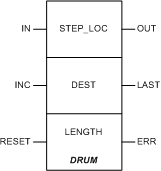|
|
(Original Document)
|
|
Name in LL984 Editor
|
Function Block Name
|
|---|---|
|
name of legacy 984 instruction
|
name in other tools and editors like:
|
 |
 |

|
Input Pin
|
Name
|
Data Type
|
Address Range
|
Meaning
|
|---|---|---|---|---|
|
Top
|
IN
|
–
|
ON = initiates L9_DRUM sequencer
|
|
|
Middle
|
INC
|
–
|
ON = step pointer increments to next step
|
|
|
Bottom
|
RESET
|
–
|
ON = resets step pointer to 0
|
|
Node
|
Node Type
|
Name
|
Data Type
|
Address Range
|
Meaning
|
|---|---|---|---|---|---|
|
Top
|
INOUT
|
STEP_LOC
|
UINT
|
%MW
|
step pointer
The %MW word entered in STEP stores the current step number. The value in this word is referenced by the function block each time it is solved. If INC is ON, the contents of the word in STEP are incremented to the next step in the sequence before the block is solved.
|
|
Middle
|
INOUT
|
DEST
|
ANY_ARRAY_UINT
|
%MW
|
step data table
first word in a table of step data information
For more information see below.
|
|
Bottom
|
IN
|
LENGTH
|
UINT
|
0...999
|
length
The integer value entered in LENGTH is the length, i.e., the number of application-specific words used in the step data table. The length can range from 0...999. The total number of words required in the step data table is the length + 6. The length must be greater or equal to the value placed in the steps used word in DEST.
|
|
Output Pin
|
Name
|
Data Type
|
Address Range
|
Meaning
|
|---|---|---|---|---|
|
Top
|
OUT
|
BOOL
|
–
|
ON = sequencer successful
(Echoes the status of the IN input).
|
|
Middle
|
LAST
|
BOOL
|
–
|
ON = step pointer value = length
|
|
Bottom
|
ERR
|
BOOL
|
–
|
ON = sequencer not successful
|
|
Word
|
Name
|
Content
|
|---|---|---|
|
DEST[1]
|
masked output data
|
Loaded by L9_DRUM each time the block is solved. Contains the contents of the current step data word masked with the output mask word.
|
|
DEST[2]
|
current step data
|
Loaded by L9_DRUM each time the block is solved. Contains data from the step pointer. Causes the block logic to automatically calculate word offsets when accessing step data in the step data table.
|
|
DEST[3]
|
output mask
|
Loaded by user before using the block. L9_DRUM will not alter output mask contents during logic solve. Contains a mask to be applied to the data for each sequencer step.
|
|
DEST[4]
|
machine ID number
|
Identifies L9_DRUM/L9_ICMP blocks belonging to a specific machine configuration.
valid range: 1 .. 9 999
All drum blocks belonging to same machine configuration have the same machine ID number.
|
|
DEST[5]
|
profile ID number
|
Identifies profile data currently loaded to the sequencer.
valid range: 1 .. 9 999
All drum blocks with the same machine ID number must have the same profile ID number.
|
|
DEST[6]
|
steps used
|
Loaded by user before using the block, specifying the actual number of steps to be solved.
valid range: 1 .. LENGTH (bottom node parameter)
|